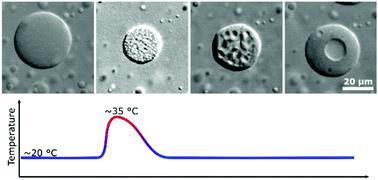当前位置:
X-MOL 学术
›
Soft Matter
›
论文详情
Our official English website, www.x-mol.net, welcomes your feedback! (Note: you will need to create a separate account there.)
Core–shell droplets and microcapsules formed through liquid–liquid phase separation of a colloid–polymer mixture
Soft Matter ( IF 3.4 ) Pub Date : 2021-08-23 , DOI: 10.1039/d1sm01091c Steven Dang 1 , John Brady 1 , Ryle Rel 1 , Sreenidhi Surineni 1 , Conor O'Shaughnessy 1 , Ryan McGorty 1
Soft Matter ( IF 3.4 ) Pub Date : 2021-08-23 , DOI: 10.1039/d1sm01091c Steven Dang 1 , John Brady 1 , Ryle Rel 1 , Sreenidhi Surineni 1 , Conor O'Shaughnessy 1 , Ryan McGorty 1
Affiliation

|
Microcapsules allow for the controlled containment, transport, and release of cargoes ranging from pharmaceuticals to fragrances. Given the interest from a variety of industries in microcapsules and other core–shell structures, a multitude of fabrication strategies exist. Here, we report on a method relying on a mixture of temperature-responsive microgel particles, poly(N-isopropylacrylamide) (pNIPAM), and a polymer which undergo fluid–fluid phase separation. At room temperature this mixture separates into colloid-rich (liquid) and colloid-poor (gas) fluids. By heating the sample above a critical temperature where the microgel particles shrink dramatically and develop a more deeply attractive interparticle potential, the droplets of the colloid-rich phase become gel-like. As the temperature is lowered back to room temperature, these droplets of gelled colloidal particles reliquefy and phase separation within the droplet occurs. This phase separation leads to colloid-poor droplets within the colloid-rich droplets surrounded by a continuous colloid-poor phase. The gas/liquid/gas all-aqueous double emulsion lasts only a few minutes before a majority of the inner droplets escape. However, the colloid-rich shell of the core–shell droplets can solidify with the addition of salt. That this method creates core–shell structures with a shell composed of stimuli-sensitive microgel colloidal particles using only aqueous components makes it attractive for encapsulating biological materials and making capsules that respond to changes in, for example, temperature, salt concentration, or pH.
中文翻译:

通过胶体-聚合物混合物的液-液相分离形成的核-壳液滴和微胶囊
微胶囊允许对从药品到香水的货物进行受控的容纳、运输和释放。鉴于各种行业对微胶囊和其他核壳结构的兴趣,存在多种制造策略。在这里,我们报告了一种依赖于温度响应微凝胶颗粒的混合物的方法,聚(N-异丙基丙烯酰胺)(pNIPAM),以及经过流体-流体相分离的聚合物。在室温下,该混合物分离为富含胶体(液体)和缺乏胶体(气体)的流体。通过将样品加热到临界温度以上,微凝胶颗粒会急剧收缩并产生更深的吸引力颗粒间电位,富含胶体的相的液滴变成凝胶状。随着温度降低回室温,这些胶状胶体颗粒液滴重新液化,液滴内发生相分离。这种相分离导致被连续的贫胶相包围的富含胶体的液滴内的贫胶液滴。在大部分内部液滴逸出之前,气/液/气全水双乳液仅持续几分钟。然而,核壳液滴的富含胶体的壳可以通过添加盐固化。这种方法创建的核壳结构具有由刺激敏感的微凝胶胶体颗粒组成的壳,仅使用水性成分,这使得它对封装生物材料和制造对温度、盐浓度或 pH 值等变化做出响应的胶囊具有吸引力。
更新日期:2021-08-31
中文翻译:

通过胶体-聚合物混合物的液-液相分离形成的核-壳液滴和微胶囊
微胶囊允许对从药品到香水的货物进行受控的容纳、运输和释放。鉴于各种行业对微胶囊和其他核壳结构的兴趣,存在多种制造策略。在这里,我们报告了一种依赖于温度响应微凝胶颗粒的混合物的方法,聚(N-异丙基丙烯酰胺)(pNIPAM),以及经过流体-流体相分离的聚合物。在室温下,该混合物分离为富含胶体(液体)和缺乏胶体(气体)的流体。通过将样品加热到临界温度以上,微凝胶颗粒会急剧收缩并产生更深的吸引力颗粒间电位,富含胶体的相的液滴变成凝胶状。随着温度降低回室温,这些胶状胶体颗粒液滴重新液化,液滴内发生相分离。这种相分离导致被连续的贫胶相包围的富含胶体的液滴内的贫胶液滴。在大部分内部液滴逸出之前,气/液/气全水双乳液仅持续几分钟。然而,核壳液滴的富含胶体的壳可以通过添加盐固化。这种方法创建的核壳结构具有由刺激敏感的微凝胶胶体颗粒组成的壳,仅使用水性成分,这使得它对封装生物材料和制造对温度、盐浓度或 pH 值等变化做出响应的胶囊具有吸引力。



























 京公网安备 11010802027423号
京公网安备 11010802027423号